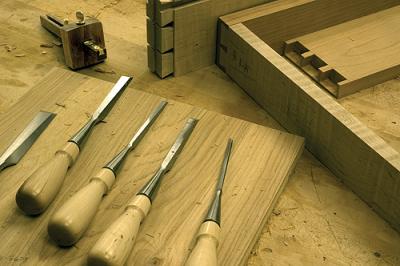Swanson's Furniture

The life of wood doesn’t end when a tree becomes a chair. It still moves with the seasons, flexes under load, absorbs and releases moisture with its environment. Where it gave shaded rest before, it now gives rest from walking and standing. Even its beauty changes only from that of wild nature to that of art. The wood is only middle aged now; it still has much life ahead.
Al Swanson is aware of what changes and what remains in the crafting of wood. He finds joy in easing and guiding that change. An equal respect for both the tree and the chair inform his decisions and techniques, and the furniture he creates honors the quiet dignity of the forest from which it came.
Al has unquestionably raised his craft to an art form. Subtle curves and harmonious proportions are standard. Aesthetic compositions grace the utilitarian purposes of his furniture. Alan and Nancy Nicholson, leaders among the Helena business community, collect his work. “Al considers everything about a customer when he has a commission. Our home is designed in the style of Frank Lloyd Wright, and Al visited often to ensure that the dining table he was building for us not only suited our needs, but also the house’s prairie style. He used complementary woods to those we had in our home, and matched the proportions to the room.” Al is regionally famous for his carefully considered designs, having pieces throughout the area’s museums, businesses, and collectors’ homes.

Al was born in 1970 and grew up near Portland, Maine, engulfed in deciduous forest that would later come to mean so much to him. The family home was a farmhouse built in the late 1700s. “When my parents moved in, there was no plumbing or electricity. My Dad did all that. We had 80 acres of farmland, and my parents had six kids, so we were all involved in keeping the gardens and animals. We resented it at the time, of course; all our friends would be out at the beach and we’d be haying, doing all that farm-work, learning how to do things. Mom cooked and canned and froze meat. We never thought of calling a repairman to fix things. If the washing machine broke, Dad taught us to take it apart and get it working, to figure it out ourselves.
“It was all about necessity. It wasn’t about choosing to live like that. Back then people were moving to the country to experiment in self-sufficiency. It wasn’t an experiment with us, it was the way things were, reality. Dad taught us to do things once, and do them right, and to take care of what we had. When we did have to buy something, we got the best quality we could, so we wouldn’t have to buy it again.”
Wood was central to their life. They cut it for heat and made maple syrup. Al learned early to identify leaves and bark, all the hardwoods and their uses. He sat in his father’s woodshop in the barn, watching as lumber became kitchen cabinets and tables to fill the family’s home. He learned to love the smell of wood chips, and slowly became fascinated with the transition of tree to furniture.

Woodworking wasn’t intended to be a career; it was simply an unquestioned way of life, something one did day to day, like housecleaning and laundry. Many of his ideas of furniture making were formed during his frequent visits to the nearby Sabbathday Shaker village, where everyday practicality and usefulness were the guiding principles of ethics and design. Today his pieces reflect the precision and usability that fascinated him in the Shaker furniture.
Throughout college and his first years on his own, woodworking steadily grew to take up his time. He got an apprentice position with a local woodworker. “He was very modest. He was a tremendous craftsman and artist, but he insisted on only calling himself a carpenter. He taught me about making joints that will work in real climates, that will move as heat and humidity flex the wood.” A small Christmas gift for a friend engendered another, and then some stools, a dining table set, and entire libraries and kitchens. Word of mouth has been more than sufficient to establish him as a leader in craftsmanship and art. After his adoption of Montana as his home in 2000, he quickly came to enjoy a reputation of being one of the leaders of the local art scene.
Al now has three woodworkers employed at his shop, all talented craftsmen in their own right. Al closely oversees and has a hand in all projects. He guides his team in all aspects of the business, from proven standards of quality to the subtleties of aesthetic design to the daily rigors of running a successful business. His shop has expanded from an unheated rented garage into a section of a warehouse and is still growing to handle the demand for Al’s work. Al has been able to move steadily away from doing standard commercial pieces. He and his group put their own style into their designs. “It’s good for us, and good for the customer,” he says. “These pieces are made with love and care. They don’t mimic the designs of other artists; the style is unique and recognizable.”

Anna Baker has worked for Al for over three years. Today her signature accompanies Al’s on most of the shop’s pieces, an evident sign of pride in their workmanship. “Al’s a perfectionist,” she says, “but he’s also confident and sure, so that he can make enough pieces to keep the business growing. He doesn’t get bogged down with uncertainty or mistakes.”
Al has a gallery at 46 South Last Chance Gulch, in Helena’s trendy downtown shopping district. The gallery isn’t just about his furniture, but rather a broader concept of living with art in one’s life. He has pieces from the region’s finest visual artists on display, creating an entire environment of taste and grace. Al’s wife Erica runs the gallery, where she invites customers to sit in one of Al’s chairs while viewing paintings by the likes of Russell Chatham, Ed Totten and Michael Haykin. Ceramic pieces from Archie Bray artists line windowsills. The effect is a study of lifestyle. “It’s about balance, about quality in all things. It’s about workmanship and style. It’s about the way we live with art,” he says.
This philosophy is apparent in his work. He hates the idea of buying cheap furniture with the idea that it will be in a landfill in a few years. “You can go to any store and see the terms ‘handmade’ and ‘craftsmanship’ thrown around as if they were cheap, easy things to come by. I try to teach people to inspect what they’re about to buy, to judge it, walk around it, crawl underneath it. Look at it from all angles. Look for the qualities of an heirloom: artistry, timeless design, and correct construction. The majority of stuff out there doesn’t match a certain code of ethics. It doesn’t support the local businessman or craftsman. It’s not sustainable, ruining a tree just to be thrown away when it inevitably breaks or goes out of fashion. It ends up being more expensive, in every way, in the long run. Sure, high-quality custom furniture can be more expensive at the outset, but the materials we use and the time and effort we put into our pieces ensure that your grandchildren can inherit this furniture in perfect condition.”

His attitude embodies a holism that covers every aspect of the business. He gets his raw lumber from certified sustainably harvested and managed forests. His finishes use a century-old oil that is both environmentally safe and repairable. In fact, the luster this finish imparts to the wood makes it difficult to keep from running one’s fingers along the surface. “I find myself constantly touching the furniture,” says Anna, “partly out of the habit of feeling for flaws, but also because it is as beautiful to touch as it is to see.”
In affiliation with the Holter Museum of Art, Al regularly gives a series of classes in woodworking. “Artists learn that it’s not just about creating the art. There’s also an element of passing the knowledge along. We have to teach it, to give it back to the community. Art constantly grows through this tradition of mentoring and sharing of ideas.” His classes may be about building a piece of furniture, but the student comes out not only with a fine piece for their home, but more importantly with an understanding of exemplary craftsmanship in all things and of making quality and art a part of one’s life.
Al’s furniture can be seen at his gallery in Helena, where he tries to be available to help people understand not only the elements of quality in his furniture, but also how a piece may fit into the customer’s home and life. Throughout this summer, the gallery will feature the works of Cathy Weber, Michael Haykin and Ed Totton, culminating later in the season with a retrospective of Al’s own work. Images of Al’s pieces and more information about his gallery can be found at www.alswanson.com or by calling 406-443-3342.
~ Rennan Rieke writes, photographs, and plays jazz upright bass in Helena, Montana.
Leave a Comment Here
Leave a Comment Here